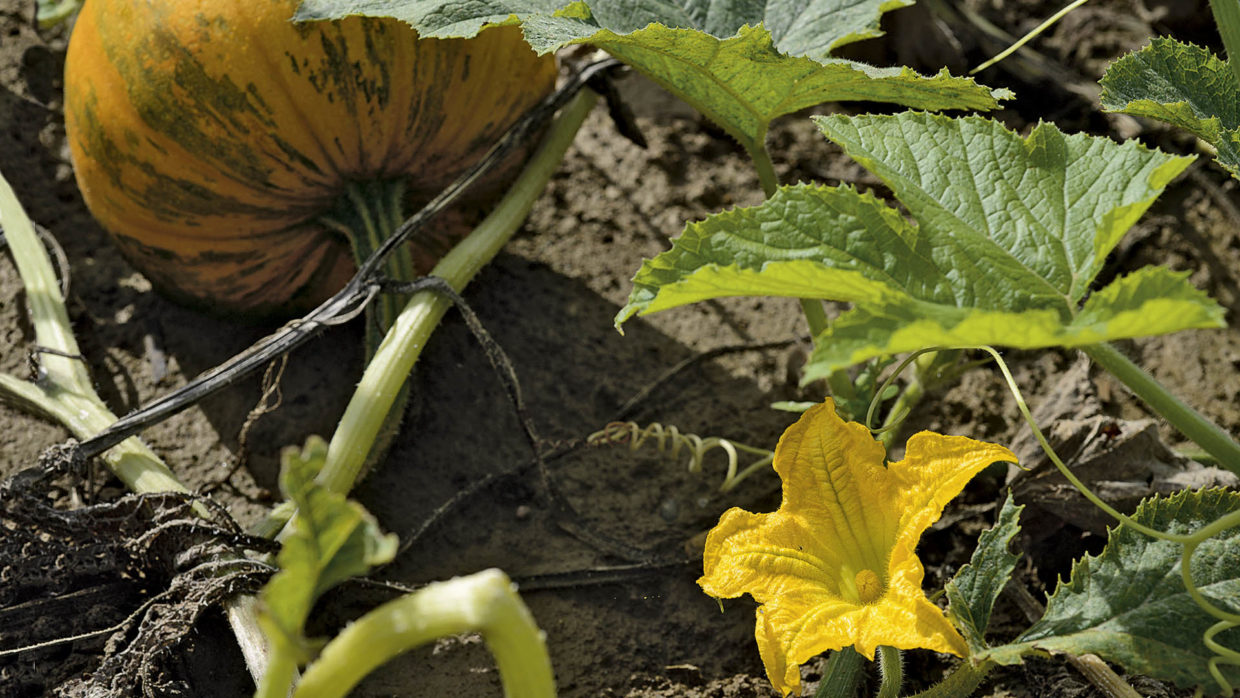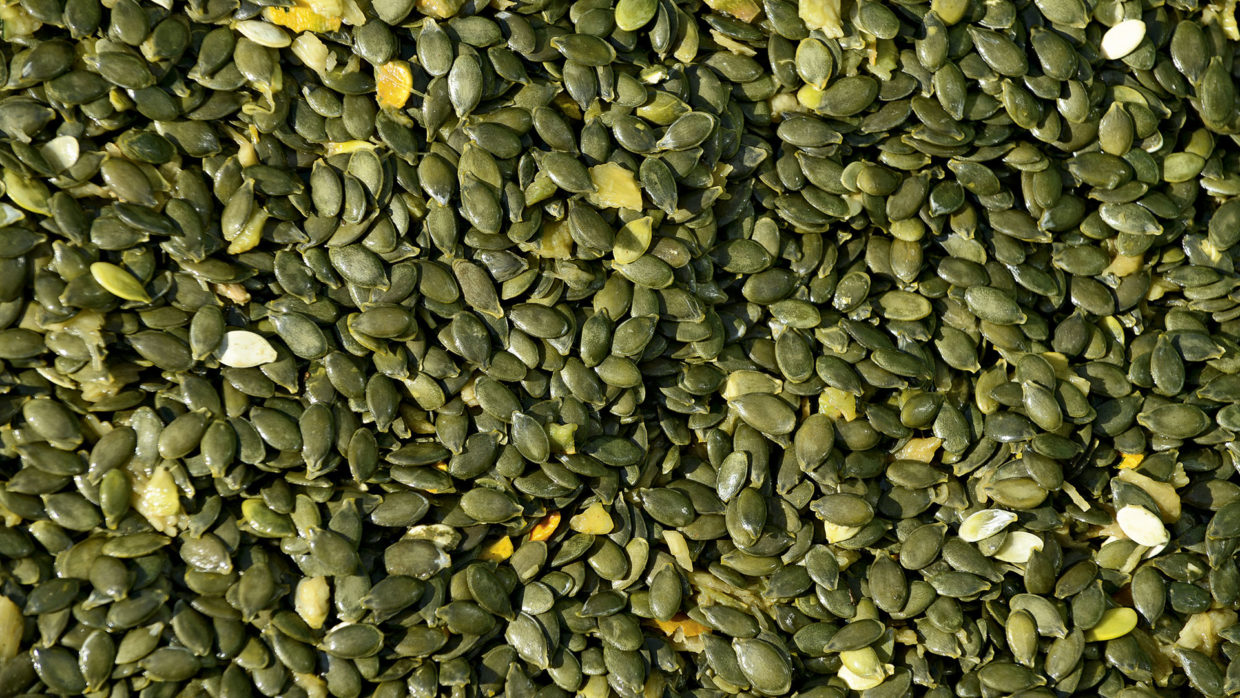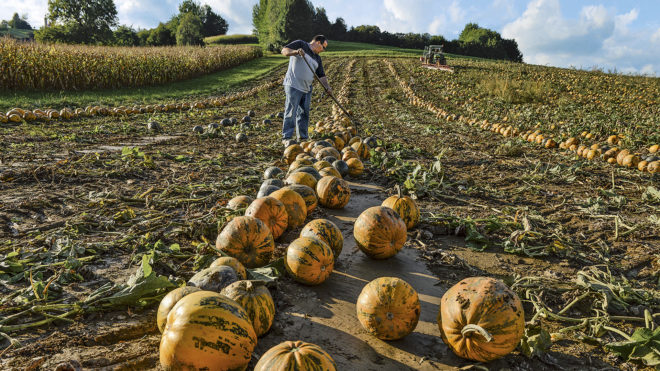Pumpkins in swaths? Threshing them? It’s hard to believe, but that’s exactly how Styrians get the seed oil which characterises the cooking culture of the whole region. On sunny September days, Austrian farmer Alois Thier, in the small town of Oberlamm, mounts a snow plough-like attachment to the front of his tractor which pushes the ripe pumpkins, almost hidden under knotweed, St John’s Wort and saltbush, together into rows.
Then, the plump, yellow, football-sized fruits are reaped by a self-propelled harvester or by a harvesting machine pulled by a tractor. In both instances, a hedgehog-like spiked roller picks up the fruits laying on the ground. A shredding barrel squashes the pumpkins and, assisted by brushes and pneumatic suction, the seeds are separated from the flesh of the fruit into a sieving drum. A conveyor then carries the slippery seeds to the tank. The chopped up flesh of the fruit ends up on the field again.

Using tractors with attachments similar to snow plows, the oil pumpkins are pushed into rows for harvesting.
The threshing technique of the harvesters act in a similar way. However, there are only six examples of these, constructed through painstaking pioneering work by contractor Karl Wilfing from Großsteinbach , who modified combine harvesters for this purpose. The advantage of this method is the speed of the harvest. In any case, the era of manual de-seeding – as was previously common practice – is well and truly over. Only very few Styrian farmers perform this manual work on small parcels of land.
Finding the right time
On the contrary, today, when the oil pumpkins cultivated on more than 9,800 ha in the southern and southwestern part of Styria turn yellow, it is a matter of urgency. The radiant dashes of colour on the pumpkin fields indicate that the required ripeness for harvesting the “green gold” contained in the seeds has been reached. “In order to pick the right harvesting time, you need to have a good, experienced knack for it. If you harvest too early, you have problems with oil quality; too late and you run the risk of the fruit decaying quickly,” says Reinhold Pucher, a member of the Working Group of Arable Farmers of the Styrian Chamber of Agriculture. “Also, no other fruit is quite so dependent on the weather,” he adds. It doesn’t like cold in the spring, often suffers from dryness in the summer and rain during the harvest quickly has a negative impact on the quality.
In order to pick the right harvesting time, you need to have a good, experienced knack for it.
Reinhold Pucher
After “threshing”, the pumpkin seeds need to be dried out from a maximum water content of 60% down to 6 to 8% within a few hours. “I know from the way a pumpkin seed cracks what its humidity level is,” Karl Höfler, a mill farmer in Kaindorf, says about the sensitive handicraft. “If the seed bends, instead of breaking, when we do the breaking tests, it is too moist,” he explains, standing in front of a tub that is heated to 130 °C, in which finely-ground pumpkin seeds are kneaded into a green pulp with water and salt and then gently roasted. The pulp then goes into a press, out of which flows the strong-tasting oil. The colour varies: the seed oil has a dark red tone to it, but looks light green in thin layers.
A secure source of income

Johannes Klein cultivates oil pumpkins.
If the aroma of their pumpkin seed oil tastes anywhere near as good as their home-baked pastries this season, Monika and Johannes Klein will not have any difficulty in directly marketing their regional product again. At an altitude of 400 m the young couple operate a sideline farm in the Styrian community of Gnas. Their farm, which has an old orchard, where lilacs, pears, peaches, walnuts and apple trees grow, is situated on the ridge of a fragmented, hilly landscape.
For the past ten years they also grow pumpkins. “The pumpkins only make up a small share of our turnover,” says Johannes Klein, who took over the farm from his parents as the youngest of seven children and works full-time at the Chamber of Agriculture. “Nevertheless, the fruit is a secure, additional source of income for us with a high added value.” While the harvesting, pressing and bottling is all contracted out, after they have siphoned off 10 l oil for their own consumption, the Kleins carry out the direct marketing under the trade mark “100% Styrian pumpkin seed oil PGI”.
Clear proof of origin
About 3,000 farmers , among them some who cultivate up to 30 ha, cultivate pumpkins in Styria. At least 75% of them are members of the Association of Styrian Pumpkin Seed Oil “Protected Geographical Indication”, PGI for short. Thirty of the mills where the seeds are pressed are also represented. Only very few people involved “do their own thing”. The employees of the Association of Styrian Pumpkin Seed Oil PGI keep a watchful eye to ensure that the Styrian origin is always clearly verifiable and also complies with the quality criteria. Only then is the manufacturer allowed to stick the band with the “PGI” endorsement to the bottle neck.
For Andreas Cretnik, Managing Director of the Association, the regional origin, coupled with the local expertise, is vital to the

That is where the name green gold comes from. The colour of the oil glimmers from black-green to a subtle olive-green.
image of Styrian pumpkin seed oil. It is the key to the further development of the valuable regional product. “Our success is 50% based on good agricultural practice, especially during the harvesting time. A skilled hand in the drying, roasting and pressing of the seeds is also important; the rest is down to marketing.”
The Managing Director expects a future annual growth of 5%. In fact, more and more consumers, especially from abroad – in Germany, France and Switzerland – use Styria’s “green gold”. In order to ensure that the success is permanent, Cretnik has a flawlessly transparent proof of origin in mind: “At the moment, there are three different methods, which only deliver partial results. ” The declared aim is, in his words, by using an oil sample to be able to precisely establish which area and which soil the pumpkins that produced the tested oil were grown in. Particularly since transparency is extremely important in these times of recurring food scandals.
An annual championship with big media coverage, where top chefs award the best farmers and processors, draws pumpkins into the spotlight. The expert also readily points out the allergen-free nature of pumpkin seed oil; the addition of artificial additives is taboo. The strong-tasting oil also supposedly has a vitamin E content five times higher than that of olive oil. Understandably, pumpkin seed oil promoters are trying to make the public aware of the health benefits of their products with new studies.
Pumpkins need good soil
Self-promotion is part and parcel of the business. Farmers who integrate pumpkins into their crop rotations are pleased, as a higher awareness of the product beyond the borders ultimately means more demand. However, growing this plant from the cucumber family is not an agricultural no-brainer. Pumpkins need good, nutrient-rich soil and there is a lot of competition with weeds and grasses. It is also unfortunate that corn rootworm is nourished by the pumpkin blossoms and therefore threatens the corn that follows. A big problem for which, as of yet, there is no solution.
However, the Styrian farmers continue to rely on their pumpkins and the cooking oil obtained from them. Pumpkin seed oil is to the Styrians what olive oil is to the Greeks, Italians or Spanish. It is a fruit that symbolises the regional identity and, moreover, embodies the distinctive flavour of Styria.
Pumpkin facts
The oil pumpkin needs good soil and a lot of warmth. Approximately 18,000 plants flourish on 1 ha at a row spacing of 70 cm. The frost-sensitive seed is placed 3 cm deep; readily available nitrogen is important for the beginning of the growth. Weeds and grasses generally persistently compete with the cucumber plant. In a normal year, a pumpkin harvest of about 5 t/ha is expected. This provides about 500 kg of seeds which, with an oil content of 40%, produce about 200 l oil/ha. The price for 1 l bottled pumpkin seed oil is currently about € 17.






